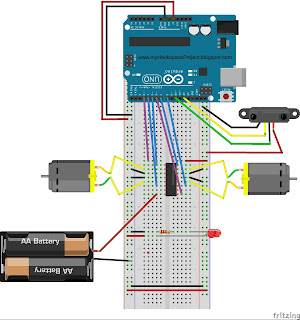HOMODRUINO®
BING - The Talking Robot
BING is an experimental Biped Neurotronic Gnoric and the first prototype in my series of autonomous Homodruinos biped intuitive machines(IM). Currently, he is undergoing a series of trial-and-error modular programming procedures to calculate his walking motions using only four servos as his Degrees of Freedom (DoF). (For a well-designed autonomous robot, I would need at least 17 servos).
I am in the process of designing a structural compartment that will serve as his body and will accommodate the Arduino board, a 9v battery, and his sonic head. In the interim, I am using an office stamp for his body, rubber bands to secure everything together in one piece, and some fasteners for his legs.
I am also developing a simple sketch that includes voice implementation for you to enjoy. If you’re interested in further experimentation, you can use the sketch provided below as a starting point. Feel free to adjust the numbers and feel fascinated with the results. Enjoy the process of building and programming Bing!
Hardware:
5 microservos
1 ultrasonic (eyes)
2 fasteners (feet and hips)
1 rubber stamp(body)
connecting wires
breadboard
Arduino R3 UNO board
Block Diagram:
Note: Same schematic. The only difference is you are adding 3 more servos. If you don't want to complicate matters, you may remove the RGB and push button circuitry.
Code # 28:
Project 28: Homodruino: The Biped Robot
Author: J. B. Wylzan with some help from the Arduino community
Website: http://www.ihackrobot.blogspot.com
Abstract: Build an autonomous Biped Robot.
================================================================== */
#include <Servo.h>
int x= 1000 ///change to 200 for dancing
Servo leftFoot;
Servo leftHip;
Servo rightHip;
Servo rightFoot;
void setup()
{
leftFoot.attach(4);
leftHip.attach(5);
rightHip.attach(6);
rightFoot.attach(7);
}
void loop()
{
stop();
forward();
}
void stop(){
leftFoot.write(90);
leftHip.write(90);
rightHip.write(90);
rightFoot.write(90);
delay(x);
}
void forward(){
leftFoot.write(80);
rightFoot.write(70);
leftHip.write(90);
delay(x);
rightHip.write(90);
leftFoot.write(70);
rightFoot.write(80);
// delay(x);
}
/* ================================================================== */
Challenge:
Create the robot with an ultrasonic sensor attached on its body.
Make Bing dance, march, walk sideways, jog and walk backward.
Actual Layout:
Procedure:
1. Build the prototype as shown above
2. Run the Arduino Interface
3. Select File > New
4. Copy Code #28 above
5. Paste Code #28
6. Click File > Save
7. Click Verify
8. Click Upload
9. Robot will move slowly forward or dance.
Disclaimer: We shall not be liable for any loss or damage of whatever nature - direct, indirect, consequential, or otherwise - which may arise as a result of your use of any information on this website. However, if you are interested in using any of the projects for personal or educational purposes, please inform the author by email.
Public Domain Notice: Copyright (c) 2000. All rights reserved. This article is part of a book entitled iHackRobot. Copies are welcome to be shared or distributed publicly as long proper citations are observed. Please cite as follows: Biotronics: The Silver Species, Joey Lawsin, 1988, USA.
"The Last Human on Earth will no longer be Human." ~ Joey Lawsin
==================================================================
Patent Pending. 2000 © ®
A L.A.W.S.I.N. Educational Production











